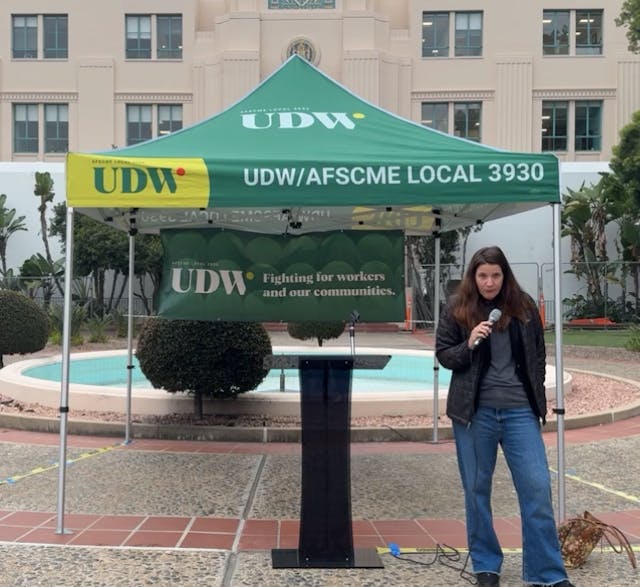Capitalism and Crisis in Acapulco
Frontera NorteSur
Part 2 of 3
For more than four years, Lauro Salinas and Julian Magana have been on strike. Seated outside the dilapidated interior of Acapulco’s Tropicana club where they worked for more than 20 years, the men recalled the glory days when the club was packed with dancers swinging to the tropical grooves. Celebrities like singer-actress Veronica Castro showed up, and part of the smash-hit 1991 soap opera “Muchachitas” starring Kate del Castillo and Laura Leon was even filmed at the now shut-down club.
But as often is the case when a family-owned business passes to the next generation, things went to hell when the owner’s daughter took over, according to Salinas and Magana. On January 30, 2009, after not getting paid for a month, the employees went on strike. Today, a handful of former waiters, affiliated with the Mexican Workers Confederation (CTM), maintain their occupation of the Tropicana and demand adequate compensation for their long years of service.
“Nobody wanted a strike, but the owner had another plan and we had to do this,” said Salinas, who serves as the CTM’s shop steward.
In an interview at the entrance to the old night spot, Salinas and Magana scoffed at severance payment offers that range from $700 to about $2,000 per worker, stressing that former owner Emilia Pavon’s employees devoted decades of their lives to the business. At its peak, the club employed 32 people, according to Salinas.
Pavon has reportedly abandoned the property, and mysterious individuals recently appeared at the site attempting to do an inspection, Salinas said. Seemingly, the workers are battling ghosts.
Labor proposals to form a cooperative and reopen the once popular club have not resonated with the state authorities, the union activist added. “Let’s open up shop so we can go to work,” Salinas proposed. At 52 years of age, the seasoned waiter said his job prospects elsewhere were virtually nil.
Magana said the strikers were prepared to keep their movement alive as long as needed. “If we’ve lasted four years, why not four more?” he declared. Meantime, the men said they survive by selling seafood, water and snacks on the beach.
The resolution of the Tropicana labor conflict has run into complicating factors.
Across the now-dusty Costera Boulevard where the Tropicana is built, workmen are busy erecting the new Acapulco branch of the National Polytechnic Institute. And it just so happens that the Club Tropicana is smack dab on the route of a new Mexico City-style municipal bus line that could be ready for service later this year.
Working 24-7, construction crews are busy tearing up the Costera to make way for the Acabus line, which is planned to move nearly 184,000 passengers over a 10-mile stretch of the city every day, according to the Guerrero state government.
In short, the Tropicana sits on a very valuable piece of real estate.
The Acabus is among several projects that propose to transform the city. While Acapulco’s violence and tourism crises have grabbed the headlines, far-reaching but far less publically discussed changes are reconfiguring the port city in many ways. Parallel to the bloody restructuring of the underworld, the re-shaping of the legal business environment is underway as well.
Roger Bergeret, director of the post-graduate program in tourism studies at the Aca-pulco branch of the Autonomous University of Guerrero, told Frontera NorteSur (FNS) that a process of “gentrific-ation” is even unfolding, citing as an example the remodeling of the historic Boca Chica Hotel into a boutique lodging.
Criminal violence, Bergeret said, has served as a “smoke-screen” for competition over Acapulco’s destiny among magnate Carlos Slim, the Azcarraga family of Televisa and the family of former President Miguel Aleman, who is credited for giving Acapulco the boost in the 1940s that made a small Pacific port into Mexico’s premier international tourist destination for years.
Like Ciudad Juarez to the north, Slim has set his eyes on Acapulco. In both instances, the cities fit the Mexican tycoon’s notion of good investment opportunities: run-down, underinvested and mismanaged enterprises that promise great profits.
Up and down the Costera, Acapulco’s nerve center, signs of decay, regeneration and contested space mingle. Empty, graffiti-splattered buildings stand alongside newly-opened businesses.
Still, new businesses keep appearing. The Costera of 2013 is overrun by Oxxo and Extra convenience stores, the Guadalajara and Similares pharmacy chains and fast food franchises. The once omnipresent silver and jewelry shops have dwindled in number, but casinos are commonplace in modern Acapulco-Play City, Yak 8, Emotion and others.
A snapshot of the new economy is readily visible in the block or two surrounding the Wal-Mart supercenter near the Costa Azul district. Inside the cavernous store, shoppers can purchase Asian-made garments, withdraw cash from the Spanish-owned BBVA-Bancomer branch, receive remittances from the United States via MoneyGram and eat at McDonald’s or Subway. Smartly attired in white shirts and red ties, Wal-Mart’s teenage baggers work for tips only.
Acapulco’s version of twenty-first century capitalism emerged amid the metamorphosis and consolidation of the previous century’s tourism-based economy.
According to records compiled by Bergeret and the UAG, the Golden Age of international tourism reigned from 1965 to 1971, when foreigners constituted from 50 to 58 percent of all visitors to the Pacific port. Acapulco remained a popular international destination throughout the 1970s and, in absolute numbers, foreign visitors reached a high water mark of 688,000 in 1978.
In 2012 international tourists numbered 13,432, according to Mexican Tourism Promotion Council figures recently reported in the local daily El Sur. The number did not include cruise ship visitors, who plunged from a recent high of 268,875 in 2007 to 3,073 in 2012. According to the Acapulco Integral Port Authority office, one cruise ship might visit the port next month.
“We’ve kept going down,” Bergeret said. “Thank god we have Mexican tourism. This is what is helping us.”
Acapulco still exhibits considerable bursts of energy. Tip-seeking fire-breathers and street acrobats perform stunts on the Costera for an overwhelmingly Mexican public while live rock and salsa bands pump out the sounds. Mexican bikers and a few Canadian colleagues roar up and down the Costera bearing the colors of the Guerrero Brotherhood, the Montreal Brotherhood, the Aca Blood Riders and others. Acapulco’s port terminal is still busy, but instead of hosting international visitors it is exporting tens of thousands of Mexican-assembled cars to foreign markets.
Acapulco’s decline as an international resort is due to different reasons. Bay pollution, traffic congestion, airline route changes, and competition from newer resorts like Los Cabos and Cancun gradually eroded the lure and power of the city. More recently, economic crisis abroad and insecurity at home proved a fatal combination. Nonetheless, a small but loyal segment of foreign visitors remains-French Canadian Baby Boomers.
“It’s very important in terms of (hotel) occupation,” said Dr. Sergio Salmeron, general mananger of the Playa Suites Hotel. “We’ve had (French Canadians) for many years, and they are bringing in a new generation.”
But another once-important market segment, U.S. spring breakers, dried up to nothing last year, Salmeron said. This season the Playa Suites expects to host 200 or so spring breakers, he added.
“It’s limited but we’re reviving the market,” Salmeron said. “It’s important for the market. We hope we’ll have an important recuperation in 2014.”
Underpinning the crisis in the tourism economy, which was once based in the hotel industry, is another key shift, in large part the result of Acapulco’s transformation from an international to a national tourist destination.
The current tourism model simply does not produce the type of income necessary to adequately support a population of more than 800,000 people, the academic stressed. Even as income from more affluent foreign tourists vanished, people kept moving to city by the Bay of Santa Lucia in search of the proverbial better life. It was after 1980, precisely when the international tourism decline began setting in, that Acapulco’s population really boomed.
The crisis manifests itself in countless ways-failed enterprises, reduced business hours, laid-off workers, wage theft, reduced revenue for government social security and housing programs, hungrier families, and delinquency.
Recently, the UAG reported almost 405,500 people, or 51.6 percent of the population, lived in poverty in 2010. Of the impoverished class, some 107,040 people were classified as subsisting in “extreme poverty,” a term Bergret defined as meaning an individual who does not know how she or he will eat for the day.
By the same token, youth grow up absorbing the glamour of the Grand Plaza and Galerias Diana shopping malls. The mall rats see pricey clothing and shoe stores with exotic names like Zingara or Oysho displaying their expensive goodies.
Burning contradictions exist between hard income and and future expectations, as well as market realities and consumer fantasties.
Immersed in a multi-faceted crisis, Acapulco’s tourism industry leaders and municipal and state officials bank on law enforcement crackdowns, better tourism promotion, the resumption of international flights and cruise ship ports of call, economic detonation from the Acabus and other mega-projects, and Carlos Slim’s deep pockets.
Bergeret is one analyst who is highly skeptical that such initiatives will make a real difference in uplifting what he regards as a burned-out tourism economy. “The market conditions have evolved but we haven’t,” said Bergeret, who served as a Guerrero state undersecretary of tourism in the 1980s and later headed Acapulco municipal government’s tourism office. “People keep wanting the federal government to help out but it hasn’t in 30 years.”
Bergeret, who admitted that his views aren’t too popular locally, said most private tourism operators and government officials still haven’t grasped the depth of the crisis and the need to pursue a dramatically different economic development strategy. “There are no new ideas,” Bergeret insisted.
The researcher suggested that Acapulco needs a radical make-over along the lines of U.S. cities like Miami or San Francisco “There are many examples internationally,” he said.
Rafael Trejo, a 40-year veteran high school teacher who is currently doing photographic documentation of Acapulco’s history and culture, also said the city must embark on a fresh path. The era of Margaritaville-style tourism and the big discos has “already passed,” Trejo told FNS.
In a piece carrying the English title “It’s not Marketing, Stupid,” local columnist Jorge Camacho Penaloza challenged calls for better tourism promotion and media coverage as the answers to Acapulco’s economic and social ills.
“To fix tourist Acapulco requires investment not only in tourism but also in society, jobs, education, family interaction and cultural values,” Camacho recently wrote. “A pact of all for Acapulco is required to resolve the problems of garbage, disorder in public transport, honest public servants, and police that aren’t allied with organized crime. In summation, more than marketing Acapulco needs a change of attitude.”






